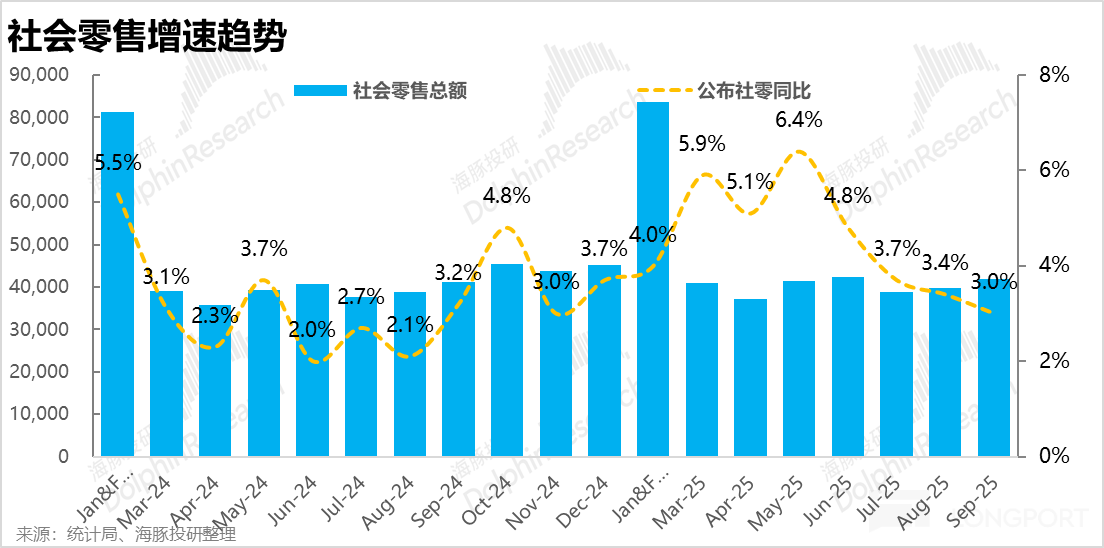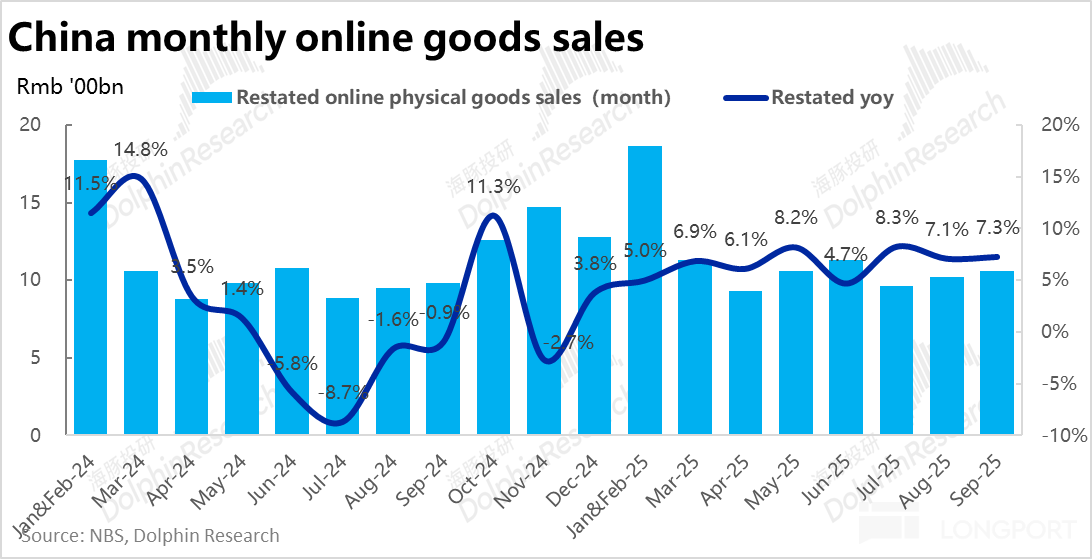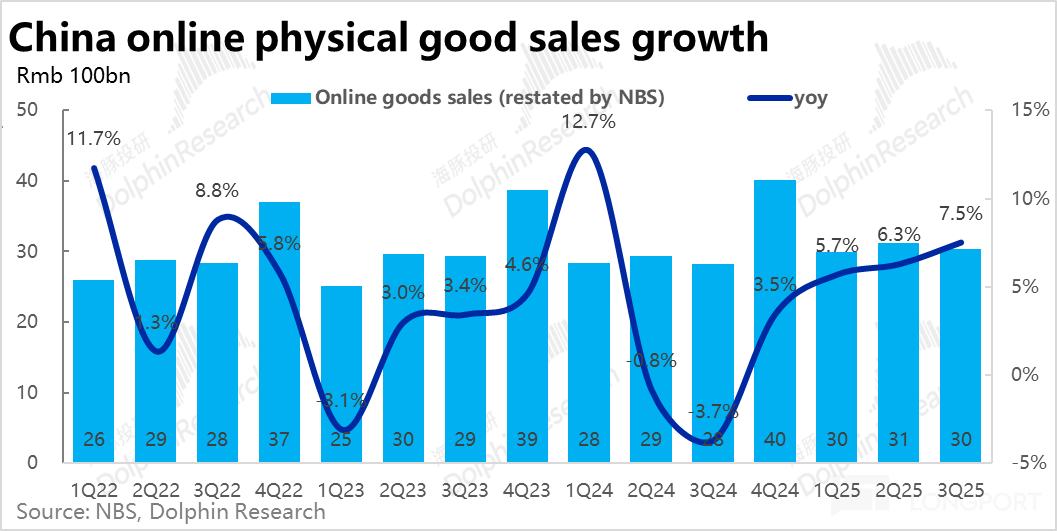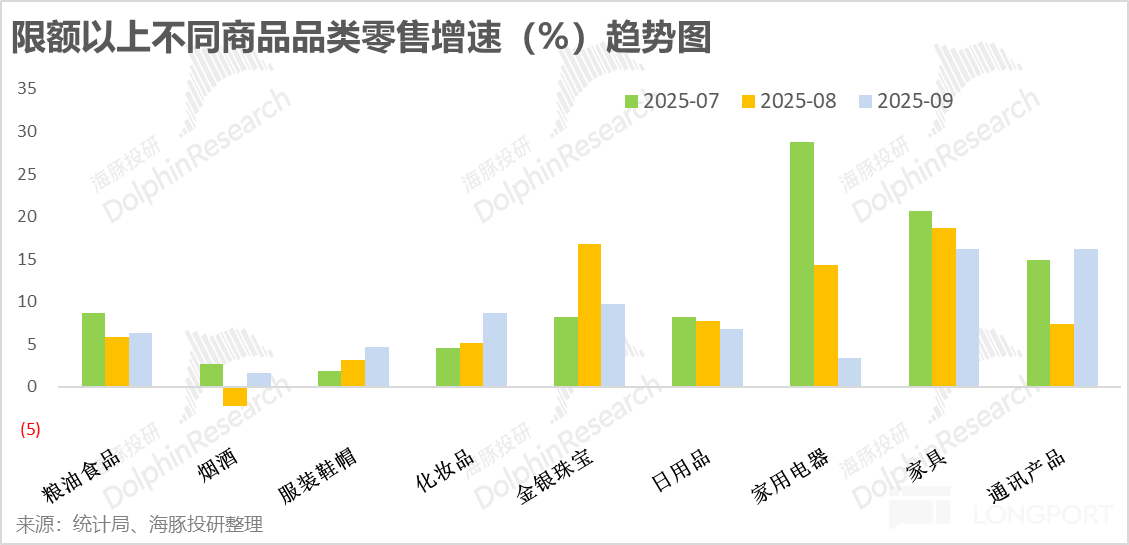
September Retail Sales Review: Revisiting the Major Low Before the Reversal in September 2024?

Today, the macro data package for September was released as scheduled. (It should be noted that the growth rate directly disclosed by the National Bureau of Statistics this year is about 1-2 percentage points higher than the growth rate calculated based on historical data. We will use the official published figures as the standard.)
Overall, Dolphin Research summarized three key points:
1) The overall retail market continues to weaken, with the year-on-year growth rate in September further declining to 3%, not far from the historical low before the major reversal in September last year. Among them, the decline in goods retail is limited, while the growth rate of catering revenue is nearly zero, which is the main drag.
2) Online channels still maintain a relative advantage, with both the monthly and 3Q overall online physical retail growth rates exceeding 7%, performing better than the first half of the year. Under the “billion-level subsidy” of the “food delivery war,” online channels are relatively better off.
3) In terms of categories, the recent high base period of last year's state subsidies. The advantageous categories of home appliances and furniture have started to become a drag. Conversely, the continuously sluggish optional categories such as clothing and cosmetics, although the absolute growth rate is still not high, have been improving for four consecutive months. There is a trend of moving away from the bottom.
1. Continued Weakness in Retail Consumption, Reaching the Pre-Reversal Low in September?
According to the data directly disclosed by the National Bureau of Statistics, the total domestic retail sales in September increased by 3% year-on-year, continuing to decline from the previous month, indicating that domestic consumer spending appears increasingly weak. If the trend does not reverse in the coming months, it may reach the low level before the major reversal in September 2024.
By type of consumption, according to the growth rate directly disclosed by the National Bureau of Statistics, the growth rates of goods retail and catering consumption are both weakening month-on-month, but the weakening of goods retail is relatively mild, mainly due to the very noticeable decline in the growth rate of catering revenue. Specifically, the growth rate of goods retail revenue is 3.3%, while the growth rate of catering revenue has plunged again to only 0.9%.
Recently, Wang Puzhong from Meituan stated in a communication that about 70% of the new food delivery orders since 2025 are “low-priced orders” with a unit price below 15 yuan. At the same time, the unit price of dine-in meals has returned to the level of 2015, ten years ago. This suggests that the intensity of competition in the “food delivery war” in September may not have eased as significantly as some investors expected.


2. Weak Overall Market but Strong Online, “Food Delivery War” Billion Subsidies Not Easing?
Similar to the previous months, in the context of overall weak retail sales, the standard for online physical retail (after adjustment) is significantly stronger. After adjustment, online physical retail in September grew by 7.3% year-on-year, and the entire 3Q quarter online physical retail grew by 7.5% year-on-year.
Although Dolphin Research reminds that a considerable portion of the data published by the National Bureau of Statistics is not comparable with historical figures, making cross-year comparisons of growth rates less meaningful (for example, comparing the growth rate of a certain month in 2025 with the same period in 2024). However, the trend of growth rate changes within a short cycle (such as within the same year) is still meaningful.
In other words, the performance of online retail in the 3Q quarter this year is not bad compared to the first half of the year, and even shows slight improvement. The hundreds of billions of subsidies invested by e-commerce platforms in instant retail and traditional shelf e-commerce over the past two quarters have indeed had some effect.
In terms of categories, sales of food, clothing, and daily necessities from January to September increased by 15.1%, 2.8%, and 5.7% year-on-year, respectively. Compared to the previous month, the growth rate of clothing, which had the worst absolute performance, improved by 0.4 percentage points month-on-month. For several consecutive months, typical categories of optional consumption in online retail have shown signs of gradually moving away from the bottom.


3. Decline in State Subsidy Benefits, Advantageous Categories Become a Drag
By product category, as we gradually enter the high base period of state subsidies starting from September last year, according to the sales data of large-scale enterprises disclosed by the National Bureau of Statistics, the sales growth rates of home appliances and furniture categories have significantly retreated. The growth rate of home appliances has dropped to only 3.3%, turning from a major driving force to a major drag.
Conversely, the optional categories that have been hovering at low levels for a long time indeed show signs of continuous improvement, with clothing, shoes, hats, and cosmetics being the two most typical optional categories, with sales growth rates rising for four consecutive months.
As for daily necessities such as food, grain, oil, and daily necessities, there are also signs of slight weakening growth. This echoes the weakening growth center of consumption.

<End of Full Text>
Risk Disclosure and Statement of this Article: Dolphin Research Disclaimer and General Disclosure
The copyright of this article belongs to the original author/organization.
The views expressed herein are solely those of the author and do not reflect the stance of the platform. The content is intended for investment reference purposes only and shall not be considered as investment advice. Please contact us if you have any questions or suggestions regarding the content services provided by the platform.







